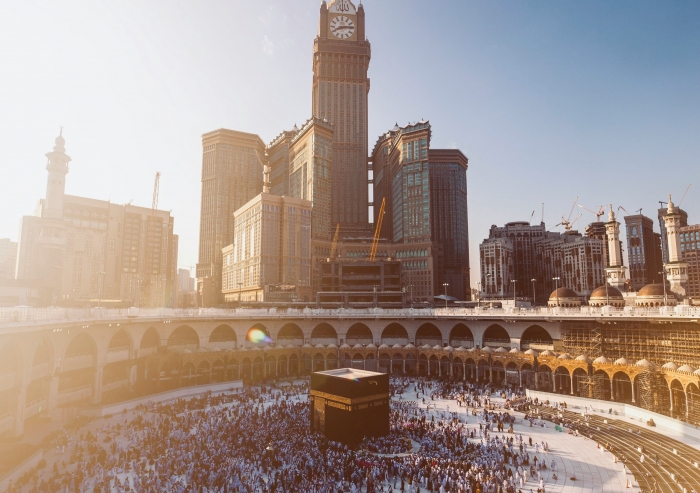Foram perseguidos pelos dirigentes de Meca, que sentiram que o Profeta estava a colocar em risco os seus interesses e o seu modo de vida, mas isso não abalou a sua crença em Allah Todo-Poderoso e não os impediu de praticar a sua fé.
No entanto, os inimigos do Profeta tornaram-se mais violentos, a ponto de fazerem um plano para o matar. Mas, quando chegaram a sua casa para o matar, encontraram Hazrat Ali a dormir na sua cama, envolto no manto verde que o Profeta usava para dormir.
Por esta altura, o Profeta tinha deixado Meca acompanhado do seu Companheiro próximo, Hazrat Abu Bakr. Com os predadores de Meca no seu encalço, esconderam-se numa guta no Monte Thawr no deserto e, enquanto os ouviam aproximar, o Profeta disse ao seu Companheiro: "Não te preocupes, Allah está connosco".
Quando os mecanos chegaram à gruta, viram uma teia de aranha a cobrir a entrada da gruta. Certamente a teia teria sido rompida se alguém tivesse entrado na gruta, pensaram. Também avistaram um ninho de pomba numa das bordas. Nenhum pássaro vaguearia nos seus ninhos se houvesse humanos por perto. Foram assim levados a pensar que a gruta estava vazia e foram embora. Allah protegeu o seu Mensageiro através de uma pequena aranha e um par de pombas.
Quando era seguro, o Profeta e Hazrat Abu Bakr continuaram a sua viagem para Medina. Esta viagem ocorreu no ano de 622 e é conhecida como a hijra, ou seja, migração. É um ano importante na história muçulmana porque marcou o ponto de viragem na missão do Profeta e um novo começo para os seus seguidores. Mais tarde, esta data marcaria o início do calendário muçulmano.
Esta história pode ser vista como um símbolo dos esforços dos muçulmanos na defesa das suas convicções e da sua luta para criarem um ambiente seguro para praticarem a sua fé. Mantenhamo-nos fortes na nossa fé em Allah Todo-Poderoso e continuemos a procurar a Sua rehmat através da prática regular da nossa fé.
Fontes:
Instituto dos Estudos Ismailis (2013) Sociedade e Civilizações Muçulmanas, volume 1, Londres: Islamic Publications Limited.
[EN]
Prophet Muhammad received the first revelation of the Qur’an in year 610 CE (Common Era), at the age of 40. At first, when he began to make his mission public, he and his followers faced serious danger. They were persecuted by the leaders of Mecca, who felt that the Prophet was endangering their interests and way of life, but this did not shake their belief in Almighty Allah and did not stop them from practising their faith.
However, the Prophet’s enemies grew more violent to the point that they made a plan to kill him. But, when they came to his house to kill him, they found Hazrat Ali sleeping in the bed, wrapped in the green cloak that the Prophet wore when he slept.
By this time, the Prophet had left Mecca accompanied by his close Companion, Hazrat Abu Bakr. With the Meccan huntsmen in pursuit, they hid in a cave on Mount Thawr in the desert and, when they heard them approaching, the Prophet said to his Companion, ‘Do not worry, Allah is with us’.
When the Meccans reached the cave, they saw a spider’s web covering the mouth of the cave. Surely the web would have been broken if anyone had entered the cave, they thought. They also spotted a dove’s nest on one of the ledges. No birds would roost in their nests if there were humans nearby. They were thus fooled into thinking that the cave was empty and left. Allah had protected His Messenger through a tiny spider and a pair of doves.
When it was safe, the Prophet and Hazrat Abu Bakr continued their journey to Medina. This journey took place in the year 622 and is known as the hijra, meaning migration. It is an important year in Muslim history because it marked a turning point in the Prophet’s mission and a new beginning for his followers. Later, this date would mark the beginning of the Muslim calendar.
This story can be viewed as a symbol of Muslims upholding to their beliefs and struggling to create a safe environment to practise their faith. Let us also remain strong in our faith in Almighty Allah and continue to seek His rehmat through the regular practice of our faith.
Sources:
Institute of Ismaili Studies (2013), Muslim Societies and Civilizations, volume 1, London: Islamic Publications Limited.
[Gujrati version]
whatsapp_ptt_20200417_hijrah.mp3







